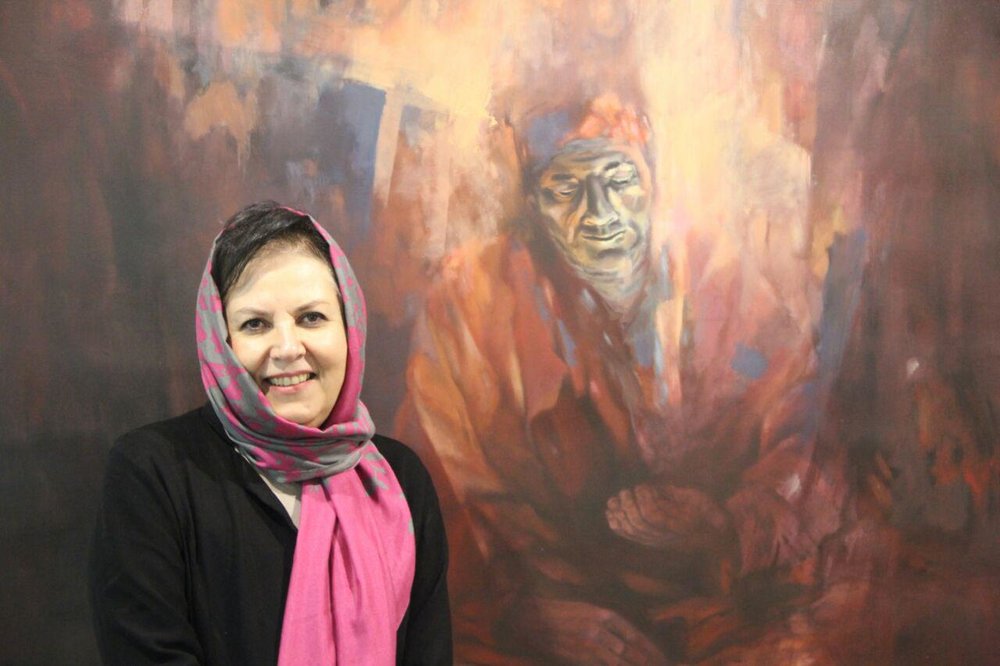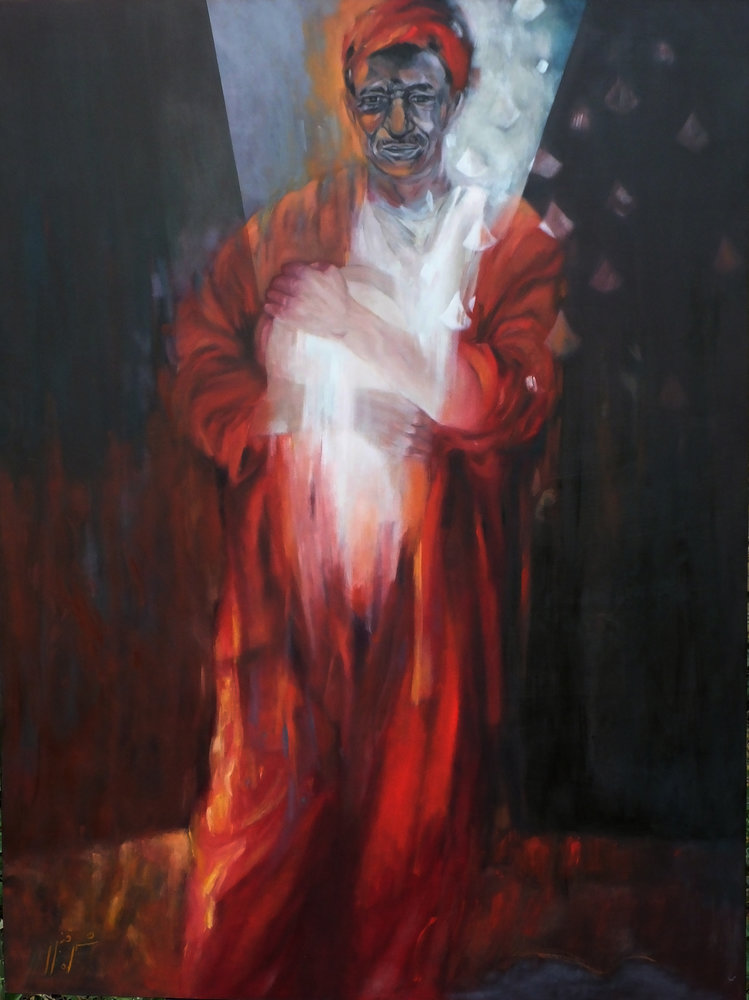Haji Firuz depicted down in Shohreh Ghanbari’s new collection

TEHRAN – Painter Shohreh Ghanbari’s new collection “Haji Firuz” shows the venerable harbinger of Noruz in a gloomy mood despite the philosophy of the occasion.
Clad in a bright red costume, Haji Firuz with his face covered with soot is seen playing his tambourine on the streets to tell people that the New Year is coming and the springtime celebration is near.
Speaking with the Tehran Times, Ghanbari said her new collection reflects the mood of modern Iranian society.
“For many, Noruz reminds of the good old memories of childhood, the sweet taste of homemade cookies, the fresh smell of new days, new dresses and gifts from relatives. All these made life beautiful and gave meaning to our lives, and made it sweet in older times,” she mentioned.
“Haji Firuz, I believe, is an Iranian personage we can also see in the dramatic arts with a slight change in siah-bazi, [a type of Iranian folk dramatic performing art]. The character of siah plays the role of this personality to tell the truth, he narrates the events and the stories in a comic tone,” she added.
“Also in the street art, Haji Firuz is a tangible personage since he promises the arrival of the New Year and the spring, and that the year will change and become new and green.
“These personages were always interesting for me, and perhaps the reason goes back to my family background. My father and grandmother played in theater and my brother Shahriar is a poet. All this led me towards art and artistic interests,” she explained.

A painting from Shohreh Ghanbari’s series “Haji Firuz”
In general, I believe an artist must be involved with the people and his/her surroundings and the world,” she remarked.
Ghanbari’s idea in the “Haji Firuz” collection was warmly received by visitors and art critics in an exhibition organized at Tehran’s Elaheh Gallery during February.
“I actually painted the contemporary Haji Firuz, who is not happy; I think the contemporary Haji Firuz cannot be happy, as we are not happy,” she said.
She also continued that her images of Haji Firuz are depicted in various positions, for example in one painting, Haji Firuz is sitting and doing nothing or in the other one the character is staring into the distance.
She later explained that although Haji Firuz is the symbol of happiness, this happiness is not seen much these days. “He has now turned into a sad figure who hardly makes a living with his black face,” she explained. “Maybe in older times, the meaning was not this bitter.
“His tambourine is also hidden in the darkness. Many visitors wanted to see a happy Haji Firuz. I tried to express my personal feelings; I could not show an artificial feeling. When the feeling has not risen within me it cannot be interesting. If I just show a Haji Firuz, well everybody knows about him, but I preferred to portray my own perception of Haji Firuz,” she added.
She continued, “I also wants to show a female Haji Firuz. That is to say that we are the actors in this life. This is the reflection of the period I am living in. If I show a happy Haji Firuz, it is not real, I must reflect this situation in my works through different elements.

A work from Shohreh Ghanbari’s series “Haji Firuz”
Haji Firuz usually narrates the current situation. I can carry the sadness of Haji Firuz and the current situation which is part of our own life in my paintings,” she remarked.
The artist also said that she may hold this exhibit in other countries, because the personage belongs only to Iran.
She also regretted that the ancient tradition of Noruz is fading away. “We have tried to save this tradition. In older times, everything was simple. There were more chances to meet, but now we are not in a mgood mood and have no patience. Life has changed and if I cannot show this change and this feeling it would result in something not real. I must try to reflect the actual feelings.”
Ghanbari has studied architecture but has always been highly interested in painting and continued with painting instead.
Her next exhibit would be in Italy. “A friend has arranged an exhibit in Rome in May and my next project centers on women to show Iranian women’s potentials to our own people and to the world, of course,” she concluded.
Photo: Painter Shohreh Ghanbari poses in an exhibition of her new collection “Haji Firuz” at Tehran’s Elaheh Gallery on February 10, 2017. (Honaronline/Ramona Mirian)
RM/MMS/YAW
